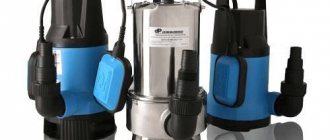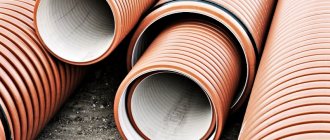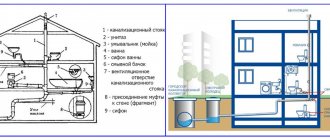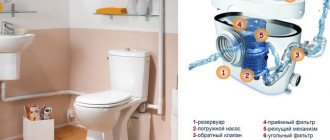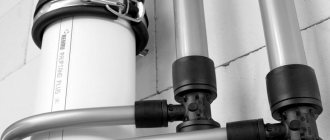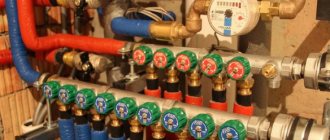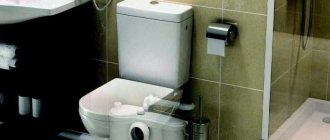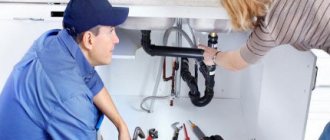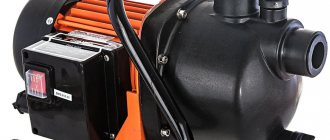The article is intended to help you understand the issues of purchasing and operating sewage pumping stations.
- Why do you need a sewer pump?
- Moving your kitchen or laundry room to another location
- Installation of an additional bathroom in the basement of the house
- Condensate pumping
- Domestic sewerage installations
- For kitchen and bathroom
- For showers and sinks
- To connect the toilet
What are they for?
The need to install this equipment in an apartment can be caused by several factors, namely the redevelopment of simple city apartments. Sometimes, to create a comfortable space, it is necessary to move the bathroom and toilet to the center of the apartment.
Sometimes the kitchen must be moved from one room to another , so that the dishwasher and sink are next to the sewer riser. In this case, the pipeline will have to be broken, and this is fraught with the formation of blockages.
In addition, a new route will have to be laid for the pipe , which may run through the hallway or room.
This is unacceptable. Sewage pumps for apartments can successfully solve such problems.
Key Features
When choosing a pump with a grinder for domestic use, you need to pay attention to the following characteristics:
- Transportation distance. When choosing this indicator, it is necessary to focus on the remoteness of the gravity sewer, and based on this, select the power. The average toilet grinder pump can transfer waste water over a distance of 70 to 100 meters horizontally or 7-10 meters vertically. Often this is enough.
- Additional connections. The possibility of combined connection will be a plus.
Advice from an expert! If there are many appliances in the bathroom that need to be connected to the pump, it is worth dividing them into groups: for hot clean drains (bathtub, washbasin, washing machine) and dirty cold ones (toilet). It is worth buying separate devices for two groups.
- Fluid temperature. Standard values are 40-90 degrees. If you plan to connect only to the toilet, then you can get by with a device with a minimum temperature. Connecting a washbasin or shower/bathtub requires pumps with a higher operating temperature.
Kinds
Conventionally, these devices are divided into two categories:
- Household;
- Industrial.
Household appliances are used for pumping wastewater and can be installed not only in country houses, but also in apartments . Industrial - used in apartment buildings and at substations that are connected to the sewer.
Household units vary in location and purpose. They also differ in the type of construction. There are devices that are installed for use by one consumer, and there are pumps used for forced sewerage of an entire house.
Pumps for sewerage in an apartment are produced in the following versions:
- For a toilet with a grinder;
- For kitchens without a chopper.
Toilet
A household sewage pump for a toilet is a box whose dimensions correspond to the size of a flush barrel with a grinder for crushing garbage that is thrown into the toilet.
The color of the device body is selected to match the color of the toilet. During drainage, the device, filled with water, begins to crush wastewater and toilet paper using blades. It cannot handle larger debris, such as personal care products.
Such a unit can pump wastewater whose temperature ranges from +35 to + 50 degrees . Many models have additional holes for connecting a shower or bidet.
In addition to such fecal pumps, there are also built-in devices with grinders that are used for wall-hung toilets . They are distinguished by their compact size, which allows them to be hidden behind a plasterboard partition.
There are models that combine a toilet and a pump . This design does not have a drain tank. It connects directly to the water supply and takes up little space.
Kitchen
Models for installation in the kitchen are called sanitary. Their purpose is to pump dirty water . The design of sanitary pumps does not contain grinders, therefore the water should not contain large fractions.
Kitchen sewer pumps
have multiple inputs to connect multiple drains from:
- Sinks;
- Bathroom;
- Shower;
- Washbasin.
When choosing a unit for the kitchen, you need to pay attention to the temperature of the wastewater . The maximum temperature of some models is +90 degrees, which allows you to connect a washing machine and dishwasher to them.
Which pump to pump out sewerage in a private house
The listed types of pumps are installed on storage tanks. This is a feature of the equipment that requires that no air gets inside the system, which could cause the pump to overheat and reduce its performance.
This is especially true for surface pumps. That is, the suction hose must be immersed in water.
In-house compact pumping stations are designed exactly according to the same principle, only a small building plays the role of a container. Pumps can be installed both inside such systems and outside, as can be seen from the photo below.
Pumping station with surface power unit
A home sewage pump is a direct analogue of the pump that is installed inside a washing machine. It is easy to use and allows you to install plumbing fixtures in any location without any problems.
Products from well-known brands, such as Grundfos or Ebara, are famous for their high reliability.
Maintenance of such pumping stations is simple - it is necessary to wash the internal storage tank at some intervals and periodically change the carbon filter, which can be installed inside to “kill” unpleasant odors.
Features of choice
Sewage pumps are designed for pumping sewage waste. They can work in a vertical or horizontal position. When positioned vertically, the pumping depth is reduced .
To choose a suitable model, you must consider the following indicators:
- Duration of operation of the device;
- Distance from the installation site to the drainage point;
- Availability of a chopper;
- Performance;
- Diameter of pipes for draining fecal matter;
- Wastewater temperature (maximum and minimum);
- Diameter of solids
Devices with grinders can be installed in any room where there are wet spots , as they cope well with large fractions.
Due to sharply sharpened knives, they crush objects entering the wastewater and prevent clogging of the system.
How it works?
Many have never encountered pumps for the kitchen, so they don’t really understand why pressure sewerage is needed and what it is. You need to understand how the device works, how it works and why it is so effective.
The sewage pump consists of the following elements:
- plastic tank with holes for pipes;
- filters;
- engine;
- launch device.
Optionally, shredders may be present. Since wastewater can emit unpleasant odors, the housing is made airtight. The device is also equipped with a check valve that prevents air from entering the apartment.
The work occurs according to the following principle:
- First, the water enters the tank.
- The autostart device determines the level of fullness of the container and, if necessary, turns on the engine (and grinders, if any).
- The engine forces water through the filter, and under pressure the pump delivers the wastewater into the sewer system. In this case, the angle of inclination does not matter, since the device can create the necessary pressure even to raise water to a significant height.
- The pump is empty and ready for use again.
Whenever it gets dirty, it is necessary to rinse the tank. Replaceable filters may also be provided, which are changed periodically.
Advantages and disadvantages
Like any other devices, fecal pumps have their advantages and disadvantages. Their advantages include:
- Compact dimensions;
- Light weight;
- Average price range;
- Easy installation without the involvement of specialists;
- High performance with minimal power consumption.
The disadvantages include:
- Stopping units during a power outage;
- The inability to drain various solvents into the sewer system that damage internal parts;
What to look for when purchasing?
Not a single company selling household pumps will sell products that are known to be of low quality. This is fraught with consequences such as conflicts with consumers, repairs at the expense of the company and additional costs. And most importantly, the company's image will suffer.
The level of pumps produced is quite high, with rare exceptions. Companies selling such units exclude from their assortment those products that have not proven themselves well in the market.
Cheap and high-quality pumps from European or domestic manufacturers are not sold on the modern market. Therefore, when choosing, you should always take this nuance into account. When purchasing, you should also check the fittings and connections , and before connecting the device, it is advisable to read the instructions.
Summary.
Before installing the sewage pump, carefully read the instruction manual, namely the part dedicated to installation. Then select the diameter of the pipe for laying the pressure part of the sewer according to special tables in the user manual. Only after this can you begin purchasing materials and installing the pump. That's all, write your questions in the comments and use the social network buttons.
What if the sewer outlet is located higher than the plumbing outlet? How then to organize the drainage of wastewater? In private houses, they made a pit into which wastewater was collected, and from there it was pumped with a submersible pump into the sewer or septic tank. Today there is another solution - a sewage pump. In many cases, its installation is cheaper, and even simpler - that’s for sure.
Connection rules
Installation of the device begins with determining the length of the pipeline and the lifting height . Both of these characteristics must correspond to the unit indicators specified in the instructions. Parameters such as elevation angle, material used and line configuration do not matter
There is one limitation during installation: you must try to avoid sharp angles of rotation of the pipe . They will create additional burden. You should not use pipes of larger diameter to connect units. Normal pressure and grinding of waste will prevent blockages in a pipe with a diameter of 45 mm.
Connection to toilet
A sewer pump with a cutting mechanism is connected to the toilet as follows:
- We lay a sewer pipe;
- We insert connecting elbows into the inlet openings of the equipment and connect the pipe to the gravity system;
- We install the unit behind the toilet and secure it to the floor with screws;
- We connect it to the pipe;
- We connect the system to the toilet. We connect the chopper to the toilet using corrugation;
- We connect the pump to the electrical network via an automatic machine. If the device is supplied with a ready-made plug, then it can only be connected to a personal socket, the cable to which is routed from the panel;
- Each connection must be secured by soldering or welding.
Wastewater from the toilet will flow into the grinder by gravity, so the toilet outlet should be located above the inlet of the grinder .
Installation in the kitchen
In the kitchen, equipment can be installed in any convenient place - under the sink or near the wall . It is important to make the calculations correctly so that the pipes have a sufficient slope and the main line itself is not too long. Otherwise, you will have to install several devices pumping water.
There are practically no installation restrictions for sewer pumps in an apartment. The main thing is to follow the instructions and not violate the operating rules . Then they will become a good assistant when remodeling your apartment and will help prevent blockages in the pipes.
What do you think of this article?
Types of pumping equipment
Depending on the technical characteristics and designs, there are several types of equipment. The toilet pump can be used under different conditions. Operation is affected by the temperature of the pumped effluent and the accumulation of solids.
Devices for cold waste
The main requirement for these pumps is temperature conditions. After exceeding +40 °C, the equipment fails. Therefore, it is important to comply with the manufacturer’s operating requirements. The devices are connected to the toilet or washbasin. It cannot be built into a drain to a bathtub or other hot springs.
